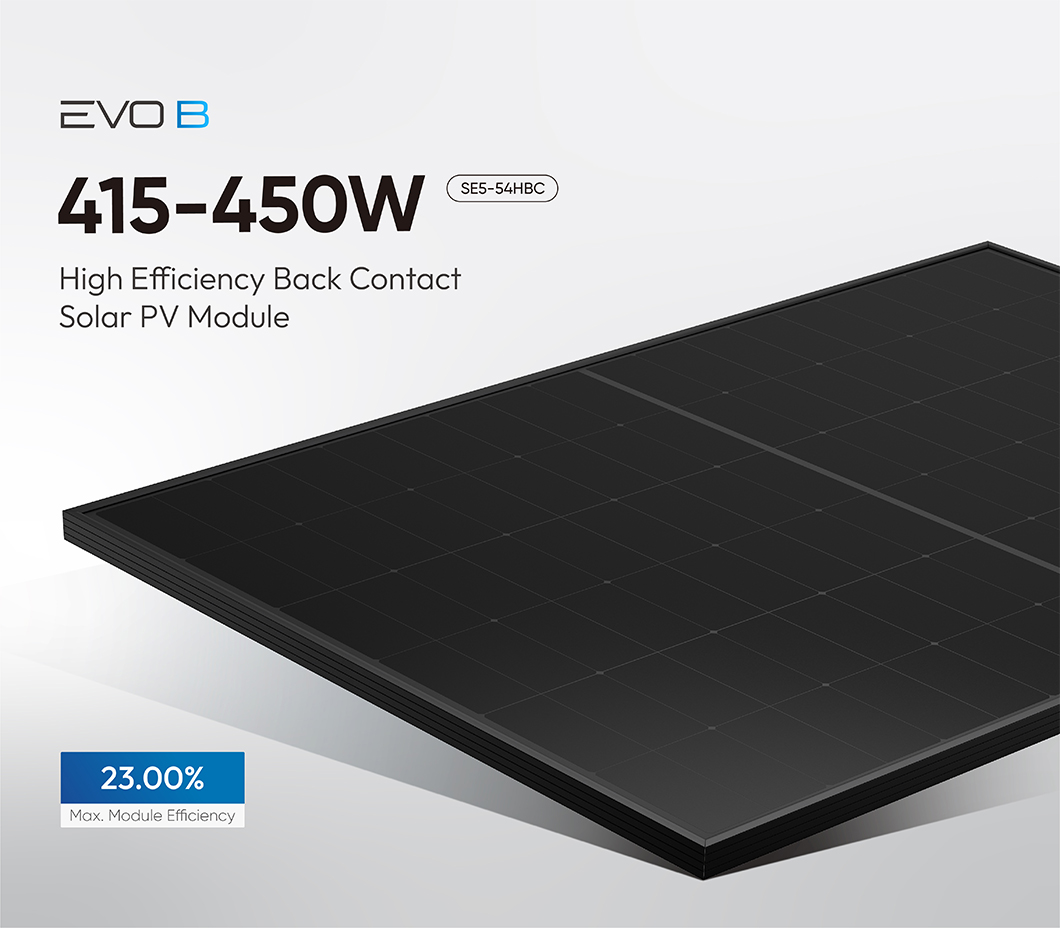The EVO B back-contact solar modules feature electrical contacts on the rear, offering enhanced aesthetics and efficiency, reduced shading issues, and improved overall durability.
Brand:
SunEvoPower Range:
415W~450WMax. Efficiency:
23.00%Number of Cells:
108 (6×18)Dimensions of Module L*W*H:
1722 × 1134 × 30mmWeight:
20.8kgFront Side Glass:
Single glass, 3.2mm coated tempered glassBacksheet:
backsheetFrame:
Anodized aluminium alloyJunction Box:
Ip68 rated (3 by pass diodes)Cable:
4mm2 , ±1200mm length can be customizedWind/Snow Load:
5400PaConnector:
Mc4 compatibleEVO B High-Efficiency Back Contact Solar PV Module 450W 445W 450W 435W 430W 425W 420W 415W
The EVO B back-contact solar modules feature electrical contacts on the rear, offering enhanced aesthetics and efficiency, reduced shading issues, and improved overall durability.

Electrical Parameters (STC*)
|
Maximum Power (Pmax/W) |
415 |
420 |
425 |
430 |
435 |
440 |
445 |
450 |
|
Maximum Power Voltage (Vmp/V) |
32.56 |
32.76 |
32.96 |
33.16 |
33.36 |
33.56 |
33.76 |
33.96 |
|
Maximum Power Current (Imp/A) |
12.75 |
12.83 |
12.90 |
12.97 |
13.05 |
13.12 |
13.19 |
13.27 |
|
Open Circuit Voltage (Voc/V) |
38.83 |
39.03 |
39.23 |
39.43 |
39.63 |
39.83 |
40.03 |
40.23 |
|
Short Circuit Current (Isc/A) |
13.78 |
13.85 |
13.93 |
14.00 |
14.08 |
14.15 |
14.23 |
14.31 |
|
Module Efficiency (%) |
21.3 |
21.5 |
21.8 |
22.00 |
22.30 |
22.50 |
22.80 |
23.00 |
|
Power Output Tolerance (W) |
0~3% |
|||||||
|
Temperature Coefficient of Isc |
+0.05%/°C |
|||||||
|
Temperature Coefficient of Voc |
-0.23%/°C |
|||||||
|
Temperature Coefficient of Pmax |
-0.29%/°C |
|||||||
High-Efficiency Back Contact Solar PV Module
High-efficiency back-contact solar photovoltaic (PV) modules are a type of solar panel that features a unique design where the electrical contacts (the metal conductors that collect the generated electricity) are located on the rear or backside of the solar cells. This design is in contrast to traditional solar panels, which have their electrical contacts on the front side. Back-contact solar modules offer several advantages:
Improved Aesthetics: Back-contact modules have a sleeker and more uniform appearance because there are no grid lines or metal busbars on the front side. This design is especially desirable for residential and architectural applications.
Enhanced Efficiency: Back-contact modules can achieve higher efficiency levels compared to conventional solar panels because the entire front surface is exposed to sunlight, maximizing light absorption.
Better Shade Tolerance: Back-contact modules are more shade-tolerant because there are no front-side gridlines that can cast shadows on the cells. This can help maintain power production in partially shaded conditions.
Durability: The absence of front-side conductive grid lines makes back-contact modules less susceptible to microcracking and potential-induced degradation (PID), which can occur in traditional modules.
Reduced Temperature Coefficients: Some back-contact designs incorporate advanced cell technologies that have lower temperature coefficients, meaning they lose less efficiency at higher temperatures.
Increased Reliability: By protecting the cells from potential environmental damage and wear on the front side, back-contact modules may offer increased long-term reliability and durability.
There are a few different technologies used in back-contact solar modules, with the most well-known being IBC (Interdigitated Back Contact) and HJT (Heterojunction Technology). These technologies often use more expensive manufacturing processes, which can make back-contact modules costlier than traditional solar panels. However, their improved performance and aesthetics can make them a worthwhile choice for certain applications, particularly in scenarios where aesthetics and space constraints are important.
It's important to note that the solar industry is continually evolving, and new technologies and designs emerge over time. Therefore, it's a good idea to consult with solar installers or manufacturers to explore the latest options available in back-contact solar modules if you're considering them for your solar energy system.